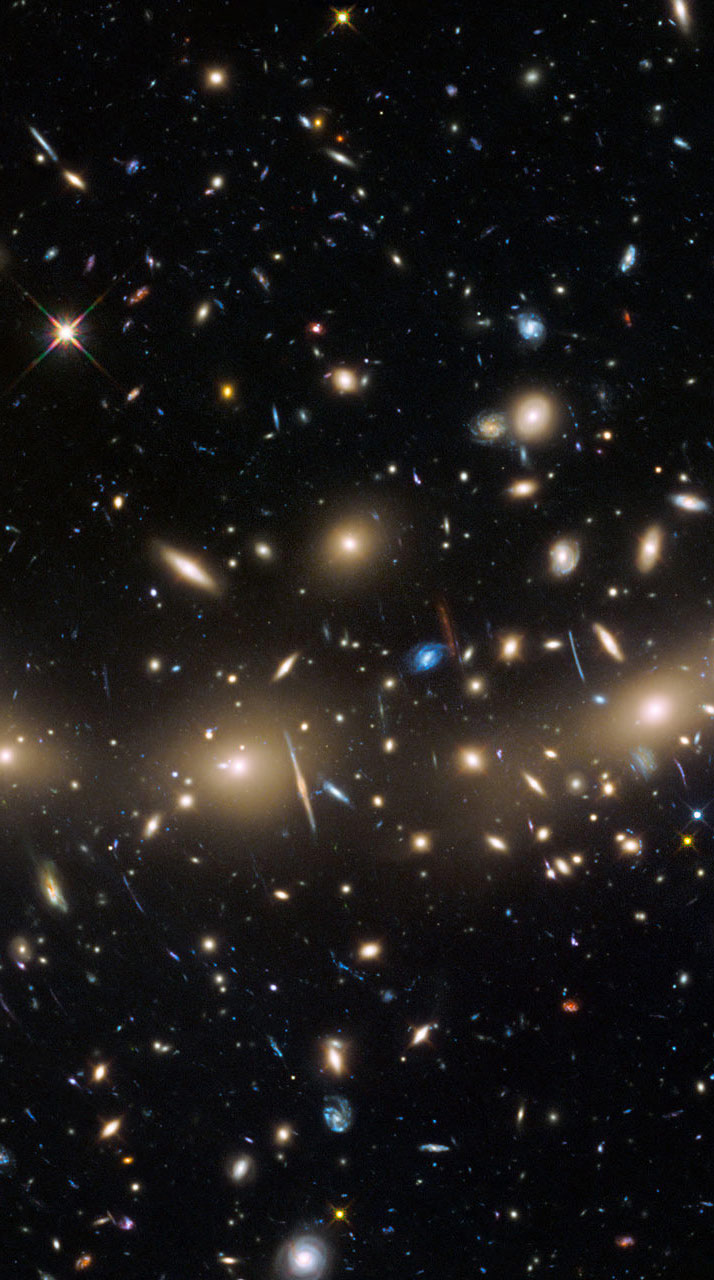Maybe you saw today's news that the universe contains "10 times as many galaxies as astronomers previously thought." Well, there's 10 times less to that announcement than meets the eye. But the real news is interesting enough.

NASA / ESA / J. Lotz (STScI)
NASA, the European Space Agency, and others issued press releases this morning announcing a new analysis of multi-instrument censuses of the Hubble Ultra Deep Field. A team led by Christopher Conselice (University of Nottingham, UK) sorted galaxies by their brightnesses and estimated redshifts to create a 3D model of which ones are at different distances and hence cosmic ages. Their study provides a better look at galaxy evolution over time, and estimates how many galaxies are too faint and far to see.
According to one press release, the team found
that 10 times as many galaxies were packed into a given [co-moving] volume of space in the early universe [as are] found today. Most of these galaxies were relatively small and faint, with masses similar to those of the satellite galaxies surrounding the Milky Way. As they merged to form larger galaxies, the population density of galaxies in space dwindled. This means that galaxies are not evenly distributed throughout the universe's history.
. . . hardly a surprise. We already knew galaxies grow in part by merging, so there will be more, little galaxies in the past and fewer, bigger galaxies in the present day.
The press release explains that the team
used new mathematical models which allowed them to infer the existence of galaxies that the current generation of telescopes cannot observe. This led to the surprising conclusion that in order for the numbers of galaxies we now see and their masses to add up, there must be a further 90 percent of galaxies in the observable universe that are too faint and too far away to be seen with present-day telescopes. These myriad small faint galaxies from the early universe merged over time into the larger galaxies we can now observe.
Again, this picture isn't news — it's just an observational confirmation of the old picture. Astronomers have known for years that, following the Big Bang, the first galaxies to form were very small and numerous compared to those today. Galaxy history since then has been all about mergers and acquisitions. The original tiny ones have been falling together to form big ones many thousands of times more massive. Some primitive dwarf galaxies are still drifting around as leftovers. Some of these are occasionally adding themselves to big galaxies, though at a much slower rate than in the past.
All these observations increasingly match the picture that's predicted by the current overarching model of cosmology, known in the trade as Lambda-CDM. This model assumes a remarkably simple Big Bang, spawned according to inflation theory, and then lets physics run from there. It has been an extremely successful match to the observed universe throughout cosmic history — all the way from evidence we can glean about the instants after the Big Bang, through cosmic evolution ever since, up to the present universe around us.
So what's new from this study? We get a better grasp on those early, unseen dwarf galaxies — the model's building blocks for today's galaxies. That's an achievement; dwarf galaxies are pretty darn elusive. The Lambda-CDM model predicts many more of them than easily meet the eye, and astronomers have been finding the missing ones only slowly. Few doubt that they're out there in one form or another. Now we have a more solid handle on them.
But How Much Galaxy is Two Trillion Galaxies?
Up to now, astronomers usually said we know of about 200 billion galaxies in the observable universe (meaning out to our event horizon, a look-back time of 13.8 billion years). Now the number can be said to be about 2 trillion, with the caveat that this estimate doesn't go back a full 13.8 billion years, it's 600 million years short. (Not many galaxies could have formed before then.) The only reason the number is 10 times bigger now is that you can legitimately include more of those littlest early building blocks; they're no longer so theoretical. The total amount of stuff — stars and gas — hasn't changed.
So no, we do not "also have to update the number of stars in the observable universe, which now numbers around 700 sextillion," as some uninformed science writers are saying. That's what they get for taking press-release hype literally.
The Lambda-CDM model predicts that the earliest clumps that formed in the smooth material after the Big Bang should have averaged about a million solar masses each (dark matter and normal matter combined). That's about the mass of a typical globular cluster today, and a millionth the total mass of the Milky Way. That's the mass down to which Conselice's team ran their extrapolations to come up with their count.
Here's their research paper.
 3
3









Comments
Lindsay
October 14, 2016 at 11:37 pm
So the Lambda-CDM model predicted dark-energy driven expansion of the universe? Does it also predict that the universe is at least 75 billion light years in diameter?
You must be logged in to post a comment.
Joel
October 15, 2016 at 9:49 am
Thank you for setting the record straight on this, Alan. The (supposed) science journalism left something to be desired on this one!
You must be logged in to post a comment.
Klarn Mxyzptlk
October 10, 2018 at 1:25 pm
Only two trillion? There have to be a lot more than that! I'm sure that, after counting them all, at least 29 brazillian will be found.
You must be logged in to post a comment.
You must be logged in to post a comment.